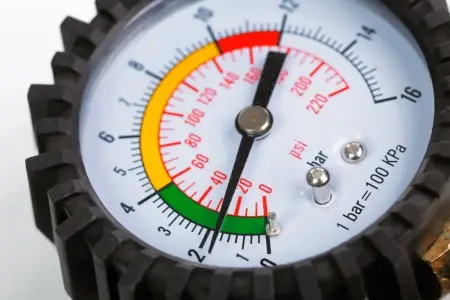
Absolute pressure is defined as the pressure measured relative to a perfect vacuum, i.e. a space where there is no matter and therefore no pressure. Unlike relative or gauge pressure, which is measured relative to local atmospheric pressure, absolute pressure takes absolute zero pressure as its reference.
Absolute pressure can be expressed by the following equation:
Pabs=Patm+Pman
where Pabs is the absolute pressure, Patm is the atmospheric pressure, and Pman is the gauge pressure. Standard atmospheric pressure at sea level is approximately 101.325 kPa (kilopascals), although it may vary with altitude and weather conditions.
Measurement units
Units of measurement for pressure include the pascal (Pa) in the International System of Units (SI), where one pascal is equal to one newton per square meter (N/m²).
Other common units are bar, psi (pounds per square inch), and torr (millimeters of mercury, mmHg), with 1 bar equal to 100 kPa, 1 psi equal to 6894.76 Pa, and 1 torr equal to 133.322 Pa.
Absolute pressure measurement
 To measure absolute pressure, devices called absolute pressure gauges or absolute pressure transducers are used. These instruments are designed to measure pressure relative to a perfect vacuum.
To measure absolute pressure, devices called absolute pressure gauges or absolute pressure transducers are used. These instruments are designed to measure pressure relative to a perfect vacuum.
Absolute pressure gauges can be of various types, of which the following are highlighted:
- Diaphragm pressure gauges : These use a flexible diaphragm that deforms under the influence of pressure. The deformation of the diaphragm is converted into an electrical signal proportional to the absolute pressure.
- Piezoresistive pressure gauges : Based on the piezoresistive effect, where the resistance of a material changes with pressure. These gauges are known for their high accuracy and are widely used in industrial and scientific applications.
- Capacitance pressure gauges : These measure absolute pressure by changing the capacitance between two conductive plates separated by a dielectric material that deforms under pressure. They are very accurate and suitable for measuring low pressures.
Differences with gauge pressure
An important distinction is the difference between absolute pressure and gauge pressure. Gauge pressure measures pressure relative to local atmospheric pressure. Therefore, if a pressure gauge reads zero, this does not mean there is no pressure, but rather that the system pressure is equal to atmospheric pressure.
In contrast, a reading of zero on an absolute pressure gauge indicates a perfect vacuum.
Practical considerations
In practice, it is critical to select the appropriate type of pressure measurement for a specific application. For example, in underwater and space applications, where atmospheric pressure varies significantly or is non-existent, absolute pressure is the most appropriate reference.
Furthermore, in industrial processes where high pressures are involved, it may be more useful to know the absolute pressure to ensure the safety and efficiency of the equipment.
Table with example values
Below is a table with examples of absolute pressures in different situations and applications. Values are expressed in pascals (Pa) and kilopascals (kPa) for clarity.
Of course, here is an updated table with examples of absolute pressures, including a value related to nuclear energy:
|
Situation / application |
Absolute pressure (Pa) |
Absolute pressure (kPa) |
Explanation |
|
Perfect vacuum |
0 |
0 |
A theoretical state without matter or pressure. |
|
Outer space (near vacuum) |
~1 × 10⁻⁶ |
~0.000001 |
The almost empty space with extremely low pressure. |
|
Laboratory vacuum chamber |
~1 × 10⁻⁵ |
~0.00001 |
Used for scientific experiments with very low pressures. |
|
Stratosphere (~30 km above sea level) |
1 000 |
1 |
Atmospheric pressure much lower than at sea level due to altitude. |
|
Standard atmospheric pressure at sea level |
101 325 |
101.325 |
Standard sea level pressure, used as a reference in many applications. |
|
Inside of a car tire (inflated) |
200 000 |
200 |
High pressure to support the weight of the vehicle. |
|
Steam in a pressure cooker |
250 000 |
250 |
Allows water to boil at temperatures above 100°C. |
|
Combustion chamber of a car engine |
3 000 000 |
3 000 |
High pressure generated during combustion in the engine cylinders. |
|
Diving tank (filling pressure) |
20 000 000 |
20 000 |
High pressures to provide sufficient air during dives. |
|
Caldera industrial |
15 000 000 |
15 000 |
Used to generate high pressure steam in industrial processes. |
|
Nuclear reactor (steam generation) |
7 000 000 |
7 000 |
High pressure in the steam generators of nuclear reactors to produce electricity. |
|
Ocean floor (10,000 m below sea level) |
110 000 000 |
110 000 |
High pressure due to the weight of the water column at great depth. |
|
Hyperbaric (high pressure) test chamber |
1 000 000 |
1 000 |
Simulates high pressures for equipment testing and training. |